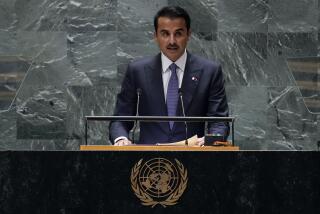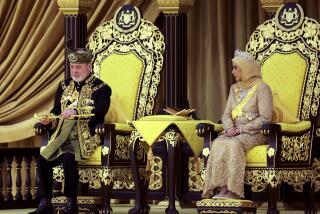THE KUWAITI ROYAL FAMILY : BACK IN POWER
- Share via
“Kuwait is liberated,” President Bush told the world in an address from the Oval Office. “Iraq’s army is defeated. Our military objectives are met.” And so, for Kuwait’s exiled leadership, the future is now. The leaders will return to a country in the midst of celebration--but will face the formidable task of recovering from the war. A look at the two top leaders, and some key challenges that lie ahead:
The Top Leaders The Emir: Sheik Jabbar al Ahmed al Sabah
He became emir in 1977, succeeding his cousin, Sabah. Born in Kuwait in 1926, he entered government service in 1949 as director of security at the oil town of Ahmadi, where he remained for 10 years. He then was named director of the country’s Finance Department. He has been considered successful in the foreign policy arena, less so in dealing with domestic situations. In 1981, he reinstated the country’s Parliament, which his predecessor had disbanded in 1976, but then disbanded it in 1986, citing dangers of anarchy. Bowing to protests, he approved a National Assembly with 25 of its 75 members government appointed. The opposition boycotted the organization.
The Crown Prince and Prime Minister: Sheik Saad al Abdullah al Sabah
His cousin, the emir, named him crown prince and heir apparent when he also appointed him prime minister in 1978. Two years younger than the emir, he served with police and security forces from 1945 to 1962 when he was appointed minister of the interior. From 1964 to 1978, he also served as defense minister. He has devoted his attention to domestic issues.
THE HISTORY
The Kuwaiti royal family traces its roots to 1756 when clans, which had settled in Kuwait city, appointed the Al Sabah as sheik. Current members of the family are descendants of sheik Mubarak, who ruled from 1896 to 1915. He established the rule of succession through his sons. Since then, except for one period, Jabbars and Sabahs have alternated as emirs.
THE GOVERNMENT
Kuwait is a constitutional monarchy established in November, 1962. The 183-article constitution was changed in 1976 when references to dissolution of the Parliament and freedom of the press were suspended. The four articles were restored in 1980, but there were subsequent attempts to change the constitution to broaden the power of the emir. The constitution defines Kuwait as an Arab state with Islam as the state religion.
KEY CHALLENGES:
Restoring Order: The Kuwaiti emir, Sheik Jabbar al Ahmed al Sabah, has declared martial law in his country for a period of three months. He appointed Crown Prince and Prime Minister Sheik Saad al Abdullah al Sabah as martial governor-general. Re-establishing governmental institutions and order in the months after the shock waves of war have subsided will be among their immediate challenges.
Rebuilding the Oil Industry: The oil industry, Kuwait’s economic lifeline, lies in shambles. Iraqi troops set hundreds of oil wells ablaze--in what allies called a “scorched earth” philosophy of war--severely damaging the infrastructure on which the industry depends. The task: Extinguishing the the fires and repairing damage to the facilities.
Rebuilding the Cities: Iraqi troops damaged scores of buildings--while looting and apparently committing atrocities--during their occupation of the country, particularly in Kuwait city. And weeks of sustained allied bombing attacks also took their toll in areas of the country. Left behind is the task of repairing or rebuilding the array of damage to buildings and dwellings.
Source: AP, Reuters and Who’s Who
More to Read
Sign up for Essential California
The most important California stories and recommendations in your inbox every morning.
You may occasionally receive promotional content from the Los Angeles Times.













